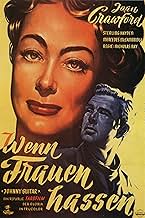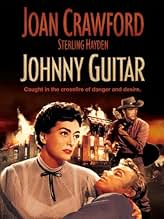VALUTAZIONE IMDb
7,6/10
20.426
LA TUA VALUTAZIONE
Dopo aver aiutato un membro di una banda ferito, una volitiva proprietaria di un saloon viene sospettata ingiustamente di omicidio e rapina in banca da parte di un linciaggio.Dopo aver aiutato un membro di una banda ferito, una volitiva proprietaria di un saloon viene sospettata ingiustamente di omicidio e rapina in banca da parte di un linciaggio.Dopo aver aiutato un membro di una banda ferito, una volitiva proprietaria di un saloon viene sospettata ingiustamente di omicidio e rapina in banca da parte di un linciaggio.
- Premi
- 1 vittoria e 1 candidatura in totale
Trevor Bardette
- Jenks
- (non citato nei titoli originali)
George Bell
- Posseman
- (non citato nei titoli originali)
Bob Burrows
- Posseman
- (non citato nei titoli originali)
Curley Gibson
- Posseman
- (non citato nei titoli originali)
Chick Hannan
- Posseman
- (non citato nei titoli originali)
Trama
Lo sapevi?
- QuizAt one point, Johnny says, "I'm a stranger here myself." This was Nicholas Ray's own personal motto, a recurring theme in his movies, and reportedly the working title for just about every movie he directed.
- BlooperAfter the bank robbery, Vienna and Johnny Guitar are riding along in a buggy drawn by a single horse. While the horse sounds like it is only trotting along, the scenery rushing past the buggy makes it appear the buggy is going at highway speed.
- ConnessioniEdited into Bonanza: The Night Virginia City Died (1970)
Recensione in evidenza
Johnny Guitar is a gender drama with obsessive personalities flirting with dementia: the character played by Mercedes McCambridge is unmistakably the main baddie, but Joan Crawford's character is not completely pleasant, grimacing as she does through much of the movie. Vienna's own sexually linked psychological fixation influences her in correspondingly curious digressions; she dresses thoroughly in white in a climactic scene where she must confront McCambridge, who dresses in black for most of the film. The men dramatically defer to the powerful determination and identities of these two women. Sterling Hayden as the eponymous hero is something less of a hero on account of Crawford's compulsion. The fact that he plays a guitar and travels without a gun gives a hint to the devalorizing of the Western hero boilerplate inferred by the title. He's a subordinate character, given to hesitation. He's mainly a bystander: His catchphrase is "I'm a stranger here myself," which can also characterize Nicholas Ray here himself.
The other male principals also take a subordinate role to the women; none of the posse, not even McIvers, its suggested chief, can bring himself to refuse McCambridge's Emma, even when lives depend on it. The Dancin' Kid makes several crucial choices, including the robbing of a bank, based on whether or not Vienna will go on reciprocating his sentiments rather than leaving him for Johnny. Johnny and the Kid are both atypically tender cowboys in contrast with the icons of the time, together with the basis that each has a creative craft that's part of his name, and that both in most cases allow the female characters to make the choices and are inclined to comply with them.
Scorsese has talked about the great theme-smugglers of the studio era who snuck subversive elements past the scrutiny of the censors. This is definitely true and admirable, but sometimes I'm baffled at what must've been functional retardation on the part of Hayes' puritan committee. This 1954 Freudian Western is one of the record out-of-the-blue phenomenons of the studio system, a film so insubordinate it's a miracle it ever got made. But despite its genre, this is a gentle, thin-skinned film, Ray's tenderest avowal of his outsider theme.
As with Ray's In a Lonely Place, On Dangerous Ground and Bitter Victory, characters come across truths that they don't want to admit to themselves or others, and sometimes this information is obvious to those around them first. He uses innuendo as a way to deal with plot developments that can't be externalized, or those that haven't come to pass yet. The characters are rounded out through teasing, accusation, high emotion.
Ray, known for his dramatic use of architecture, was keen on the meanings of the horizontal line, which serves a western particularly well. The first and second halves of the film have different visual styles. But both sections feature extensive panning. The second half features brilliant landscape photography, as Ray's camera pans over snow-covered mountain roads and trails. These sections are unusual in that they don't feature wilderness areas. Instead, these scenes always have human habitations in them: roads, farmhouses, paths, and other human constructions. They can be described as rural, or as tourist areas: the sort of remote but inhabited location one might go to on vacation. Such locales rarely pop up in movies. Westerns, which feature vast landscapes, tend to have wilderness areas without modern buildings. And contemporary films rarely go to such poverty stricken tourist spots, preferring resort and wilderness areas with more glamour.
However, no matter what intellectual appreciation movie buffs and film scholars and critics have for it, it's impossible to deny its utterly ham-fisted acting and soapy plot strands, all approaching out-and-out kitsch. I've seen a good deal of westerns with more understated, salt-of-the-earth acting that brought me closer to the grit inherent to its environment. This is the diametric opposite of being one of them. Did any of them have whiplash after a certain amount of takes? Why such intense about-faces and comic-book demeanor? Was Douglas Sirk on set? After awhile, I gave up on the performances. Their imaginations don't seem engaged. They pretend self-consciously. They're stiff, tightly wound. They never let go. And though Crawford is never uninteresting or by any means bad in any film in which I see her, I feel she should've been told as much as necessary that acting is not a competition, that everything must be done for the good of the film or everybody else is put at risk. But she's not the only one who showboats here; everybody does. Despite a cast of performers that tend to intrigue me, the two females, Hayden, Ernest Borgnine, I could only rely on Ray's building of tension through montage and his marshaling of the plot to keep me engaged. Nevertheless, Johnny Guitar is a certain kind of film that has upheld its rank by repositioning itself every decade since its release.
The other male principals also take a subordinate role to the women; none of the posse, not even McIvers, its suggested chief, can bring himself to refuse McCambridge's Emma, even when lives depend on it. The Dancin' Kid makes several crucial choices, including the robbing of a bank, based on whether or not Vienna will go on reciprocating his sentiments rather than leaving him for Johnny. Johnny and the Kid are both atypically tender cowboys in contrast with the icons of the time, together with the basis that each has a creative craft that's part of his name, and that both in most cases allow the female characters to make the choices and are inclined to comply with them.
Scorsese has talked about the great theme-smugglers of the studio era who snuck subversive elements past the scrutiny of the censors. This is definitely true and admirable, but sometimes I'm baffled at what must've been functional retardation on the part of Hayes' puritan committee. This 1954 Freudian Western is one of the record out-of-the-blue phenomenons of the studio system, a film so insubordinate it's a miracle it ever got made. But despite its genre, this is a gentle, thin-skinned film, Ray's tenderest avowal of his outsider theme.
As with Ray's In a Lonely Place, On Dangerous Ground and Bitter Victory, characters come across truths that they don't want to admit to themselves or others, and sometimes this information is obvious to those around them first. He uses innuendo as a way to deal with plot developments that can't be externalized, or those that haven't come to pass yet. The characters are rounded out through teasing, accusation, high emotion.
Ray, known for his dramatic use of architecture, was keen on the meanings of the horizontal line, which serves a western particularly well. The first and second halves of the film have different visual styles. But both sections feature extensive panning. The second half features brilliant landscape photography, as Ray's camera pans over snow-covered mountain roads and trails. These sections are unusual in that they don't feature wilderness areas. Instead, these scenes always have human habitations in them: roads, farmhouses, paths, and other human constructions. They can be described as rural, or as tourist areas: the sort of remote but inhabited location one might go to on vacation. Such locales rarely pop up in movies. Westerns, which feature vast landscapes, tend to have wilderness areas without modern buildings. And contemporary films rarely go to such poverty stricken tourist spots, preferring resort and wilderness areas with more glamour.
However, no matter what intellectual appreciation movie buffs and film scholars and critics have for it, it's impossible to deny its utterly ham-fisted acting and soapy plot strands, all approaching out-and-out kitsch. I've seen a good deal of westerns with more understated, salt-of-the-earth acting that brought me closer to the grit inherent to its environment. This is the diametric opposite of being one of them. Did any of them have whiplash after a certain amount of takes? Why such intense about-faces and comic-book demeanor? Was Douglas Sirk on set? After awhile, I gave up on the performances. Their imaginations don't seem engaged. They pretend self-consciously. They're stiff, tightly wound. They never let go. And though Crawford is never uninteresting or by any means bad in any film in which I see her, I feel she should've been told as much as necessary that acting is not a competition, that everything must be done for the good of the film or everybody else is put at risk. But she's not the only one who showboats here; everybody does. Despite a cast of performers that tend to intrigue me, the two females, Hayden, Ernest Borgnine, I could only rely on Ray's building of tension through montage and his marshaling of the plot to keep me engaged. Nevertheless, Johnny Guitar is a certain kind of film that has upheld its rank by repositioning itself every decade since its release.
I più visti
Accedi per valutare e creare un elenco di titoli salvati per ottenere consigli personalizzati
- How long is Johnny Guitar?Powered by Alexa
Dettagli
- Data di uscita
- Paese di origine
- Lingua
- Celebre anche come
- Johnny Guitar - Gejagt, gehaßt, gefürchtet
- Luoghi delle riprese
- Azienda produttrice
- Vedi altri crediti dell’azienda su IMDbPro
Botteghino
- Lordo in tutto il mondo
- 7.218 USD
- Tempo di esecuzione1 ora 50 minuti
- Colore
Contribuisci a questa pagina
Suggerisci una modifica o aggiungi i contenuti mancanti

Divario superiore
By what name was Johnny Guitar (1954) officially released in India in English?
Rispondi





































